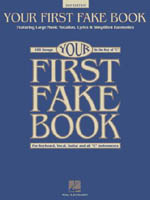Various Your First Fakebook [2nd edition]
Fakebooks - Pop/Rock

-
Various
Your First Fakebook [2nd edition] [C instruments]
This is a beginning fake book for players new to "faking." By using a fake book, musicians learn to "fake" an accompaniment to a melody, playing chords as indicated. This book is designed for those players just acquiring this important musical skill. It includes 100 favorite songs that belong in all musicians' repertoire library, including standards, pop hits, Broadway and movie songs, folk favorites, and much more. All the songs are in the key of C and include easy-to-read, large notation complete withlyrics. Chords have been simplified, but remain true to each tune. This book even includes an introduction on how to use a fake book. Contents: Ain't Misbehavin' (from AIN'T MISBEHAVIN'); Alexander's Ragtime Band (from ALEXANDER'S RAGTIME BAND); All The Things You Are (from VERY WARM FOR MAY); Alley Cat Song; America, The Beautiful (Tune Name: MATERNA); Annie's Song; As Long As He Needs Me (from the Columbia Pictures - Romulus Motion Picture Production of Lionel Bart's); Audition (The Fools Who Dream) (from LA LA LAND); Beauty And The Beast (from BEAUTY AND THE BEAST); Bewitched (from PAL JOEY); Blackbird;Blame It On My Youth; Blue Suede Shoes (from G.I. BLUES); Blueberry Hill; Bring Him Home (from LES MISERABLES); Bye Bye Love; Can You Feel The Love Tonight (from THE LION KING); Can't Help Falling In Love (from the Paramount Picture BLUE HAWAII); Can't Help Lovin' Dat Man (from SHOW BOAT); Can't Smile Without You; Chariots Of Fire (from the Feature Film CHARIOTS OF FIRE); (They Long To Be) Close To You; Colors Of The Wind (from POCAHONTAS); Do-Re-Mi (from THE SOUND OF MUSIC); Don't Cry For Me Argentina(from EVITA); Don't Get Around Much Anymore (featured in SOPHISTICATED LADIES); Don't Know Much; Earth Angel; Edelweiss (from THE SOUND OF MUSIC); Falling In Love With Love (from THE BOYS FROM SYRACUSE); Falling Slowly (from the Motion Picture ONCE); Fascination; Fly Like An Eagle (featured in the Motion Picture SPACE JAM); Georgia On My Mind (featured in RAY); Get Me To The Church On Time (from MY FAIR LADY); Getting To Know You (from THE KING AND I); The Greatest Love Of All; A Hard Day's Night (from A HARD DAY'S NIGHT); He's Got The Whole World In His Hands (Tune Name: WHOLE WORLD);
Heart And Soul (from the Paramount Short Subject A SONG IS BORN); Hello, Dolly! (from HELLO, DOLLY!); Hey Jude; Honeysuckle Rose (from AIN'T MISBEHAVIN'); Hotel California; Hound Dog (featured in the Motion Picture A FEW GOOD MEN); How Sweet It Is (To BeLoved By You); I Can't Give You Anything But Love (from BLACKBIRDS OF 1928); I Could Have Danced All Night (from MY FAIR LADY); I Could Write A Book (from PAL JOEY); I Walk The Line (featured in WALK THE LINE); I've Got You Under My Skin (from BORN TO DANCE); If I Had A Hammer (The Hammer Song); In The Still Of The Night (from ROSALIE); Isn't It Romantic? (from the Paramount Picture LOVE ME TONIGHT); Just The Way You Are; Lean On Me; Leaving On A Jet Plane; Let It Be (featured in the Broadway Musical LET IT BE); Love Me Tender (featured in LOVE ME TENDER); Lover Man (Oh, Where Can You Be?); Manhattan (from the Broadway Musical THE GARRICK GAIETIES); Maria (from THE SOUND OF MUSIC); A Million Dreams (from THE GREATEST SHOWMAN); Mood Indigo (featured in SOPHISTICATED LADIES); My Favorite Things (from THE SOUND OF MUSIC);
My Funny Valentine (from BABES IN ARMS); My Heart Stood Still (from A CONNECTICUT YANKEE); My Romance (from JUMBO); No Other Love (from ME AND JULIET); Oh, What A Beautiful Mornin' (from OKLAHOMA!); Oklahoma (from OKLAHOMA!); Ol' Man River (from SHOW BOAT); On The Street Where You Live (from MY FAIR LADY); Raindrops Keep Fallin' On My Head (from BUTCH CASSIDY AND THE SUNDANCE KID); River Flows In You; Satin Doll (featured in SOPHISTICATED LADIES); Seventy Six Trombones (from Meredith Willson's THE MUSIC MAN); Smoke Gets In Your Eyes (from ROBERTA); Somewhere Out There (from AN AMERICAN TAIL); Stand By Me (featured in the Motion Picture STAND BY ME); Stormy Weather (Keeps Rainin' All The Time) (from COTTON CLUB PARADE OF 1933); Summertime (from PORGY AND BESS(R)); Sweet Caroline; That Old Black Magic (from the Paramount Picture STAR SPANGLED RHYTHM); This Is Me (from THE GREATEST SHOWMAN); This Land Is Your Land; Till There Was You (from Meredith Willson's THE MUSIC MAN); Try To Remember (from THE FANTASTICKS); Unchained Melody (from the Motion Picture UNCHAINED); The Way You Look Tonight (from SWING TIME); What Kind Of Fool Am I? (from the Musical Production STOP THE WORLD - I WANT TO GET OFF);
When I Fall In Love (featured in the TriStar Motion Picture SLEEPLESS IN SEATTLE); When I'm Sixty-Four (from YELLOW SUBMARINE); When The Saints Go Marching In; Where Or When (from BABES IN ARMS); A Whole New World (from ALADDIN); Yesterday; You Made Me Love You (I Didn't Want To Do It) (from BROADWAY MELODY OF 1938); You're Nobody 'til Somebody Loves You (featured in the Broadway Musical CONTACT); Young At Heart (from YOUNG AT HEART)
-
- Category: Fakebooks - Pop/Rock
- Item: 127733
- Grade/Level:
- Price: $24.99
-
(usually ships in 10 to 15 days)
